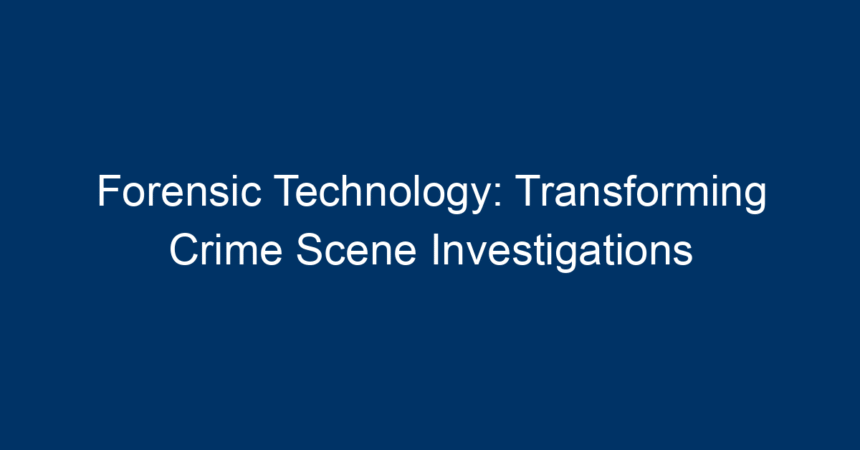In a world where crime rates fluctuate and justice can often feel elusive, forensic technology has emerged as a beacon of hope. Gone are the days of relying solely on witness statements and circumstantial evidence. Today, crime scene investigations are more sophisticated than ever, leveraging cutting-edge technology to solve cases, gather evidence, and achieve justice for victims and their families. In this article, we will explore how forensic technology is reshaping crime scene investigations, the key tools involved, and the future implications for law enforcement.
Understanding Forensic Technology
Forensic technology refers to the application of scientific methods and advanced technology in the investigation of crimes. This multi-disciplinary field encompasses various domains, including biology, chemistry, physics, and even computer science. The primary goal of forensic technology is to collect, preserve, and analyze evidence that can link suspects to criminal activity or exonerate the innocent.
The Evolution of Forensic Technology
The roots of forensic science can be traced back centuries, but its modern revolution began in the late 20th century. The introduction of DNA profiling in the 1980s was a game-changer, allowing law enforcement to connect suspects to crime scenes with unprecedented accuracy. Since then, advancements in forensic technology have grown exponentially, incorporating digital forensics, trace evidence analysis, and biometry.
Key Tools in Forensic Technology
1. DNA Analysis
DNA analysis is perhaps the most influential advancement in forensic technology. By examining genetic material found at crime scenes—such as hair, blood, or skin—law enforcement can create a genetic profile. This profile can then be matched with databases or used to identify victims or suspects.
2. Digital Forensics
As society increases its reliance on digital devices, digital forensics has become crucial to investigations. This field involves recovering and analyzing data from computers, smartphones, and networks to uncover criminal activities. From tracking online behavior to recovering deleted files, digital forensics can often provide a clear picture of a suspect’s actions before and after a crime.
3. Ballistics Analysis
Ballistics technology helps determine the origin and use of firearms in crimes. Forensic specialists analyze bullet casings, trajectory, and other physical evidence to identify the type of weapon used. This analysis can be pivotal in linking a suspect to a crime scene and can even assist in ruling out potential suspects based on the type of ammunition found.
4. Fingerprint Analysis
While not new, fingerprint analysis continues to evolve with technology. Automated Fingerprint Identification Systems (AFIS) streamline the comparison process, allowing investigators to match fingerprints collected at crime scenes with those in a database quickly.
5. Chemical Analysis
Chemical analysis techniques, such as gas chromatography and mass spectrometry, are instrumental in comprehensive drug testing and toxicological analysis. These methods can identify the presence of substances in bodily fluids, providing insight into potential motives or circumstances surrounding a crime.
The Importance of Crime Scene Protocol
Securing the Scene
Forensic technology can only be effective if the crime scene is properly secured. Investigators must follow strict protocols to prevent contamination or loss of evidence. This includes establishing a perimeter, documenting the scene through photographs, and collecting evidence systematically.
Evidence Collection Techniques
Utilizing forensic technology in evidence collection is essential. Advanced techniques such as laser scanning and 3D modeling allow investigators to create accurate representations of crime scenes, preserving critical details that may otherwise be missed. This technology helps to visualize the scene and understand the dynamics of events that occurred.
Case Studies: Real-World Applications of Forensic Technology
The Golden State Killer Case
One of the most famous examples of forensic technology in action is the capture of the Golden State Killer. Using genetic genealogy, law enforcement was able to trace familial DNA found at crime scenes back to a suspect. This innovative approach led to the arrest of Joseph James DeAngelo, demonstrating the power of forensic technology in solving cold cases.
The Unabomber Identification
In a different scenario, the identification of Ted Kaczynski, the Unabomber, serves as a testament to the effectiveness of forensic psychology and digital forensics. Authorities matched his writing style to the manifesto published in major newspapers, while digital forensics helped corroborate his identity, ultimately leading to his arrest.
The Future of Forensic Technology
While we have come a long way, the landscape of forensic technology is constantly evolving. Here are a few trends that may shape its future:
1. Artificial Intelligence (AI)
AI is beginning to revolutionize forensic investigations by enhancing data analysis and pattern recognition. AI algorithms can sift through vast amounts of data swiftly, identifying connections and anomalies that human investigators might miss.
2. Advanced Imaging Techniques
Techniques such as hyperspectral imaging may allow investigators to visualize evidence that is invisible to the naked eye. This could lead to breakthroughs in cases where traditional forensic methods fall short.
3. Blockchain for Evidence Integrity
As concerns grow over evidence tampering, blockchain technology may offer a solution. By creating an immutable record of evidence collection and handling, law enforcement can ensure the integrity of the evidence presented in court.
Conclusion: Embracing Forensic Technology
Forensic technology is transforming crime scene investigations, bridging the gap between science and justice. As it continues to evolve, its potential to enhance public safety and bring about justice cannot be overstated.
Actionable Insights
- Stay Informed: Law enforcement agencies should prioritize ongoing training in forensic technologies to keep pace with advancements.
- Collaborate with Experts: Building partnerships with forensic specialists can enhance criminal investigations and improve evidence collection methods.
- Public Education: Raising awareness about the role of forensic technology in solving crimes can foster community support and engagement.
By embracing these advancements, we not only innovate crime scene investigations but also pave the way for a future where justice is served more effectively and efficiently.




